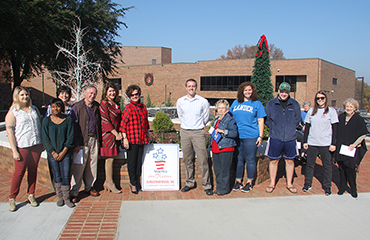
Lander University celebrated Arbor Day recently with the planting of a Katsura Claim Jumper tree, which was donated by the Greenwood Council of Garden Clubs (GCGC).
While speaking to the assembled crowd of about 60 guests and students outside on Moran Assembly Plaza, JoAnn Purkerson, chair of the Arbor Day activities for the GCGC and Lander University Arboretum Committee member, shared the origin of Arbor Day, which was first celebrated in Nebraska in 1872, the same year that Lander was founded as Williamston Female College.
Greenwood horticulturalist and Lander Arboretum Committee member John Elsley said the Katsura Claim Jumper, the scientific name of which is Cercidiphyllum japonicum, is native to Japan and known for its "stunning golden foliage," in both spring and fall. The leaves actually emerge with a pink blush and are accompanied by a scent that some claim is similar to cotton candy. The tree should reach a mature height of 25 feet.
Dr. Andrew Schwendemann, president of the Lander Arboretum Committee and assistant professor of Biology, spoke to the crowd about the crucial positive impact trees have on the environment and in the daily lives of humans.
"Tress have been around for about 400 million years, and have had a tremendous effect on how Earth has developed since that time," Schwendemann said. "Through single-cell division, trees eventually grow into organisms comprised of trillions and trillions of cells through photosynthesis. By doing this, trees bring in water from the soil, carbon dioxide from the atmosphere and light from the sun that will use sugars to build up their bodies. The oxygen trees release into the air is vital to other living things, and it's estimated that one acre of trees releases enough oxygen each year for 18 people to live."
Far from being solitary organisms, recent research has shown that many trees communicate with one another - regardless of species - via signals transferred through a network of underground fungi and chemical smells.